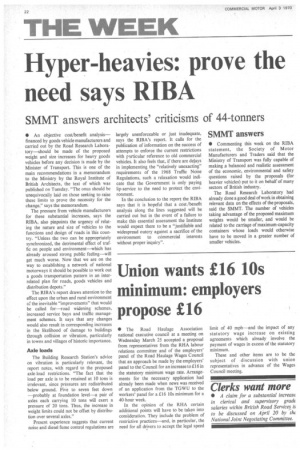Hyper-heavies: prove the need says RIBA
Page 24

If you've noticed an error in this article please click here to report it so we can fix it.
SMMT answers architects' criticisms of 44-tonners
• An objective cost/benefit analysis— financed by goods vehicle manufacturers and carried out by the Road Research Laboratory—should be made of the proposed weight and size increases for heavy goods vehicles before any decision is made by the Minister of Transport. This is one of the main recommendations in a memorandum to the Ministry by the Royal Institute of British Architects, the text of which was published on Tuesday. "The onus should be unequivocally laid on those seeking to raise these limits to prove the necessity for the change," says the memorandum.
The pressure from vehicle manufacturers for these substantial increases, says the RIBA, also pinpoints the urgency of relating the nature and size of vehicles to the functions and design of roads in this country. "Unless the two can be appropriately synchronized, the detrimental effect of traffic on people and environment—which has already aroused strong public feeling—will get much worse. Now that we are on the way to establishing a network of national motorways it should be possible to work out a goods transportation pattern in an interrelated plan for roads, goods vehicles and distribution depots."
The RIBA's report draws attention to the effect upon the urban and rural environment of the inevitable "improvements" that would be called for—road widening schemes, increased service bays and traffic management schemes. It says that any changes would also result in corresponding increases in the likelihood of damage to buildings through collision or vibration, particularly in towns and villages of historic importance.
Axle loads The Building Research Station's advice on vibration is particularly relevant, the report notes, with regard to the proposed axle-load restrictions. "The fact that the load per axle is to be retained at 10 tons is irrelevant, since pressures are redistributed below ground. Five to seven feet down —probably at foundation level—a pair of axles each carrying 10 tons will exert a pressure of 20 tons. Thus, the increase in weight limits could not be offset by distribution over several axles."
Present experience suggests that current noise and diesel fume control regulations are largely unenforceable or just inadequate, says the RIBA's report. It calls for the publication of information on the success of attempts to enforce the current restrictions with particular reference to old commercial vehicles. It also feels that, if there are detays in implementing the "relatively unexacting" requirements of the 1968 Traffic Noise Regulations, such a relaxation would indicate that the Government is only paying lip-service to the need to protect the environment.
In the conclusion to the report the RIBA says that it is hopeful that a cost /benefit analysis along the lines suggested will be carried out but in the event of a failure to make this essential assessment the Institute would expect there to be a "justifiable and widespread outcry against a sacrifice of the environment to commercial interests without proper inquiry".
SMMT answers
• Commenting this week on the RIBA statement, the Society of Motor Manufacturers and Traders said that the Ministry of Transport was fully capable of making A balanced and realistic assessment of the economic, environmental and safety questions raised by the proposals (for heavier vehicles) put to it on behalf of many sectors of British industry.
The Road Research Laboratory had already done a good deal of work in obtaining relevant data on the effects of the proposals, said the SMMT. The number of vehicles taking advantage of the proposed maximum weights would be smaller, and would be related to the carriage of maximum-capacity containers whose loads would otherwise have to be moved in a greater number of smaller vehicles.








































































































